
Brought to you by:
Enterprise Strategy Group | Getting to the Bigger Truth™
ESG TECHNICAL VALIDATION
Veritas NetBackup Flex Scale: Simple, Automated Data Protection Services
With a Scale-out, Hyperconverged, Containerized Platform
By Kerry Dolan, Sr. Validation Analyst; and Vinny Choinski, Sr. Validation Analyst
AUGUST 2021
ESG Technical Validations
Introduction
Background
Figure 1. IT and Data Protection Challenges
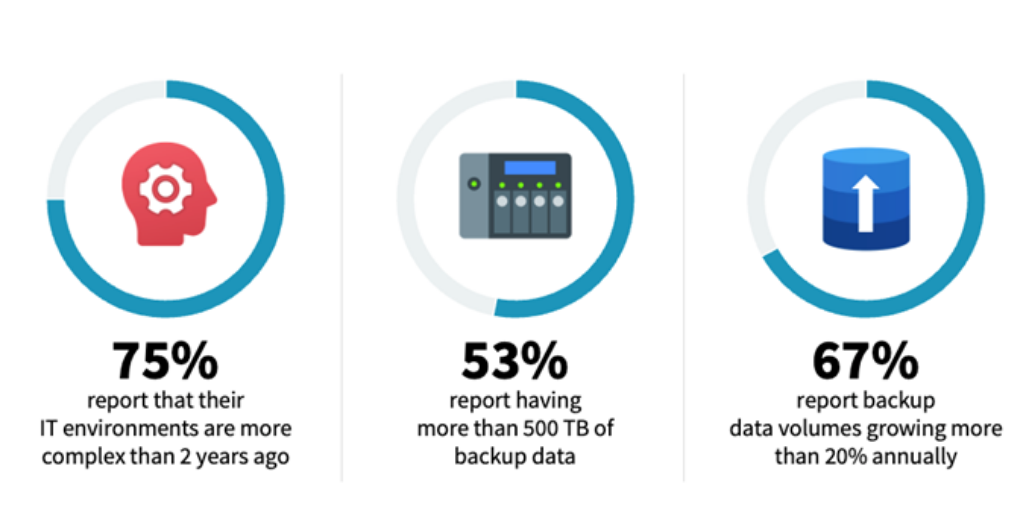
Source: Enterprise Strategy Group
NetBackup Flex Scale
Figure 2. NetBackup Flex Scale Architecture
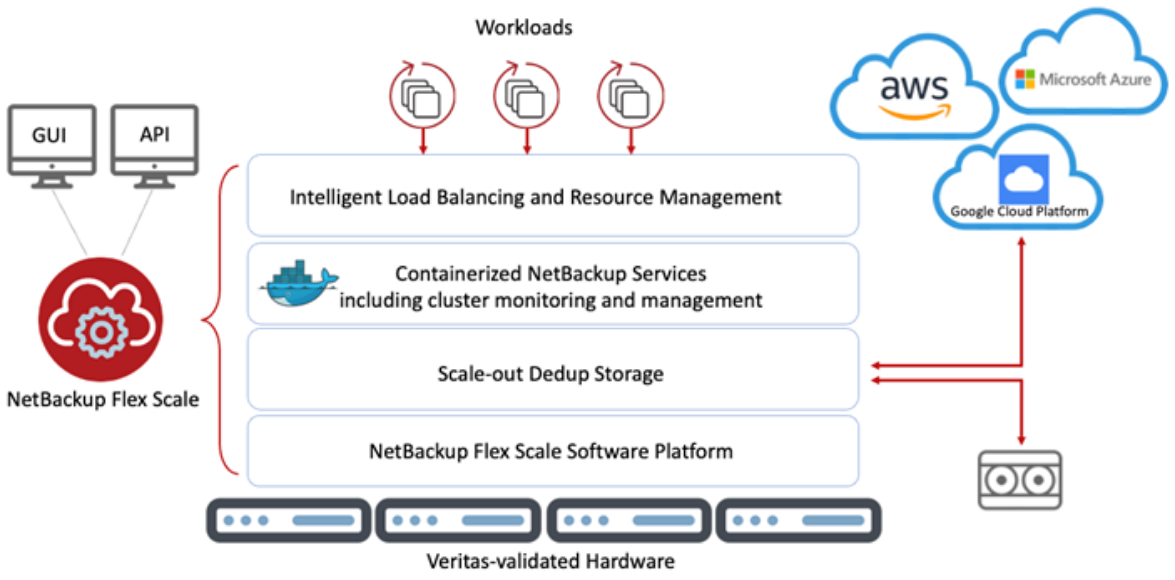
Source: Enterprise Strategy Group
- 2 x 16 Intel Xeon processors.
- 192GB of RAM.
- 2 x 7.68TB NVMe SSDs for catalog and metadata.
- 12 x hot-swappable, 14TB SAS HDDs for backup data.
- 2 x 10/25 GbE dual port adapters, with support for VLANs and optional bonding.

A private UDP network with two 25Gbps ports connects the nodes in the cluster, providing more bandwidth and performance than TCP.
The NetBackup Flex Scale software platform includes the customized RHEL OS, hardened with built-in security enhancements to minimize threats.
There are numerous features and automations built into NetBackup Flex Scale that contribute to its ease of management.
- Intelligent load balancing and resource management. Instead of using a round-robin system that doesn’t consider resource usage, NetBackup Flex Scale has an intelligent, containerized load balancer that knows the load on each node and distributes tasks intelligently. When additional resources are needed, new nodes are added and NetBackup Flex Scale automatically spins up new containers and services. Administrators have no need to even know if they need more services; they are just created automatically. Should a container fail, NetBackup Flex Scale will automatically restart it in place; should a node fail, NetBackup Flex Scale will redistribute and restart services across available nodes. When nodes are added or replaced, the new nodes are automatically added to the resource pool. All of this happens non-disruptively.
- Containerized NetBackup services. NetBackup services, including media and master services, are all containerized using Docker. They are created automatically during the initial configuration and distributed across all nodes. There is no need for a direct connection to specific services; all clients connect to an alias for services, eliminating any client-side impacts for policy or hardware changes. Container snapshots make rolling upgrades simple and fast, and container management is built into NetBackup Flex Scale using the embedded Veritas InfoScale functionality.
- Scale-out, deduplicated storage. At initial configuration, all HDDs are aggregated into a single storage pool. Efficient data storage is guaranteed with NetBackup’s built-in Media Server Dedup Storage Pool. As nodes are added, new HDDs are included in the pool.
- Nodes can be added singly or in pairs, up to 16 nodes; each node adds 112 TB of usable capacity, for a total of 1.8 PB of usable storage in a single domain. Resiliency increases as nodes are added. NetBackup Flex Scale can also write directly to the cloud and out to tape.
- The backup catalog is placed on SSDs in each node and protected with triple mirrors, as well as with default catalog backup and snapshot policies; replication options are also available. The catalog is automatically scaled as the cluster scales, eliminating the need for administrators to monitor or manually increase catalog capacity.
- Data is protected with erasure coding 8:4, with each two-MB data slice divided into data fragments and parity fragments and spread across nodes and disks in the cluster. This offers the greatest balance of capacity, performance, and data durability; NetBackup Flex Scale can survive the loss of any four disks in the cluster with no data loss. Erasure coding is block-based, eliminating the performance impact of cluster management tasks related to garbage collection.
ESG Technical Validation
Ease of Deployment and Scaling
Initial Deployment
Figure 3. Completed Set-up Wizard
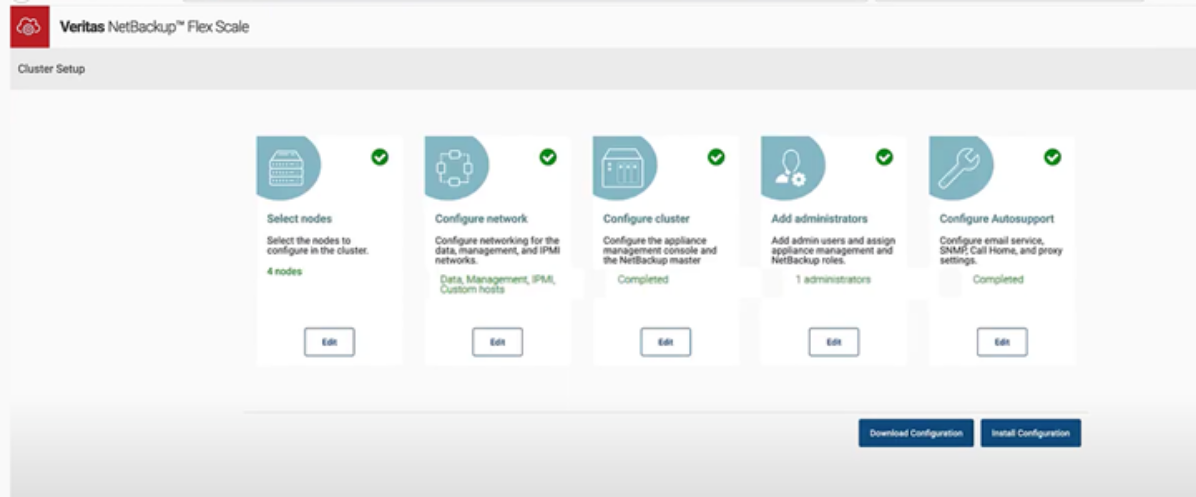
Source: Enterprise Strategy Group
- After clicking Start under Select Nodes, NetBackup Flex Scale detected and listed all four nodes in the cluster, which we then selected. We browsed to and opened a YAML file containing configuration details to avoid manual entry that can be error prone. All configuration details were then pre-populated, so we only needed to confirm them in subsequent screens. For example, the domain, cluster, and individual node names were then visible on the Select Node screen.
- We confirmed network configurations next, including IP addresses for the data network for NetBackup services, including media servers; the management network, including nodes and DNS; and the optional IPMI network and custom host files.
- Next, we validated cluster configuration details, including the management console, NetBackup Master server, and time zone. License keys are added here as well.
- Then, we added the usernames of appliance and NetBackup administrators with defined roles, and finally, we verified the optional Autosupport details, including email addresses, SNMP contacts, and call home and proxy settings.
Figure 4. NetBackup Flex Scale Automatic Deployment
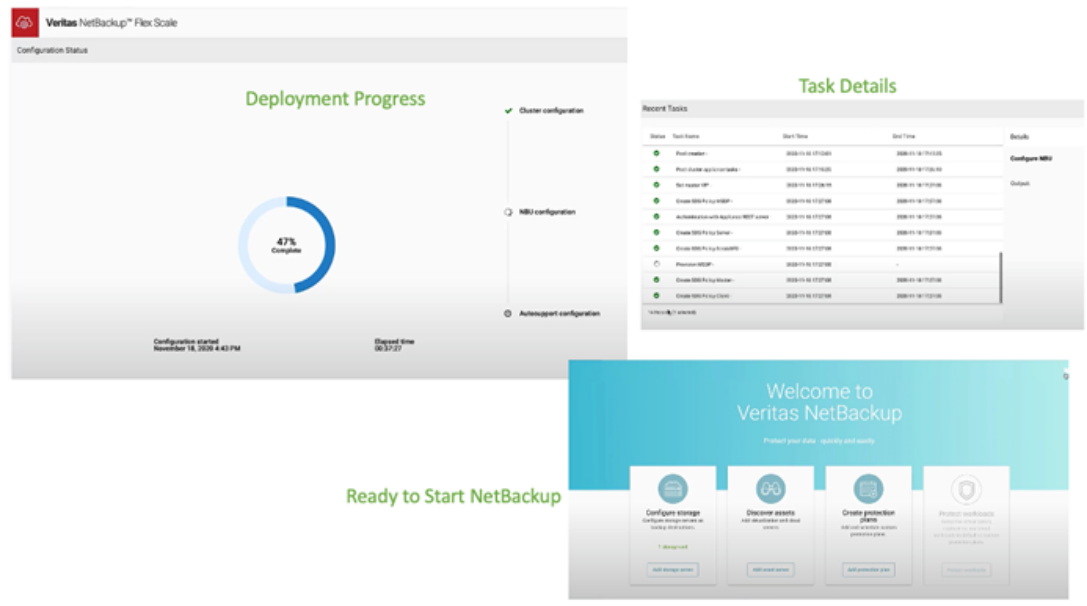
Source: Enterprise Strategy Group
Add Node
Figure 5. Automated Node Addition
Source: Enterprise Strategy Group
Why This Matters
Growing data volumes and management complexity complicate data protection, often resulting in data vulnerability.
ESG validated that NetBackup Flex Scale, with its containerized, hyperconverged, scale-out architecture, offers simple, automated deployment and scalability. Using the easy set-up wizard, deployment took less than five minutes of administrator time, after which NetBackup Flex Scale completed the installation on its own. Adding nodes to the cluster was equally easy, requiring just a few clicks. NetBackup Flex Scale automatically added the nodes, scaled the clustered file system, and rebalanced data across the expanded cluster, with no changes to policies or clients.
Resiliency and Automation
Table 1. NetBackup Flex Scale Resiliency Increases with Additional Nodes
| Cluster Size | Maximum # of Supported Failures | ||
|---|---|---|---|
| 4-5 Nodes | Any 4 HDDs, or | 1 Node + Any 1 HDD, or | 1 Node |
| 6-12 Nodes | Any 4 HDDs, or | 1 Node + Any 2 HDDs, or | 2 Nodes |
| 12+ Nodes | Any 4 HDDs, or | 1 Node + Any 3 HDDs, or | 2 Nodes |
Source: Enterprise Strategy Group
Backups Continue During Failures
Figure 6. Node Failure with Uninterrupted NetBackup Jobs
Source: Enterprise Strategy Group
Replace Node
Why This Matters
Modern businesses demand high availability of applications and data to remain competitive and compliant.
With block-based erasure coding 8:4, the minimum NetBackup Flex Scale cluster can survive losing four disks, with resiliency increasing as nodes are added. Data replication is also supported, as are non-disruptive upgrades and node replacements, and the NetBackup catalog is automatically protected with triple mirrors, snapshots, and scheduled backups. ESG validated that NetBackup Flex Scale continued running backups and snapshots during multiple disk failures; we also validated NetBackup Flex Scale’s fast, automated node replacement, with automatic data rebuilding and cluster re-balancing. NetBackup Flex Scale’s extensive automation saves administrator time and reduces errors, ensuring high availability of data.
Performance
ESG Testing
- Because it is a scale-out system, as nodes are added, additional disk, CPU, and network resources are added to serve I/O requests; this enhances performance by spreading the workload among more resources. Data is deduplicated, speeding backup performance; the higher the dedupe rate, the faster backups can be completed.
- NetBackup Flex Scale’s parity calculation is fast because it uses a version of Reed-Solomon code that leverages processor optimization. As a result, only a single operation is required per processor.
- Because NetBackup Flex Scale uses block-based erasure coding (versus file- or object-based), there is no need to consume cycles and slow performance while the system reclaims space from temporary replicas or landing zones.
- Instead of using TCP, NetBackup Flex Scale uses UDP for the cluster interconnect among the commodity hardware nodes, delivering 50% more IOPS, according to Veritas. Because NetBackup Flex Scale handles network management across the cluster, there is also no need for NIC bonding, removing another performance obstacle.
Figure 7. Scalability of Backup Performance
Scalable Backup Performance with Varying Dedup Rates (more is better)
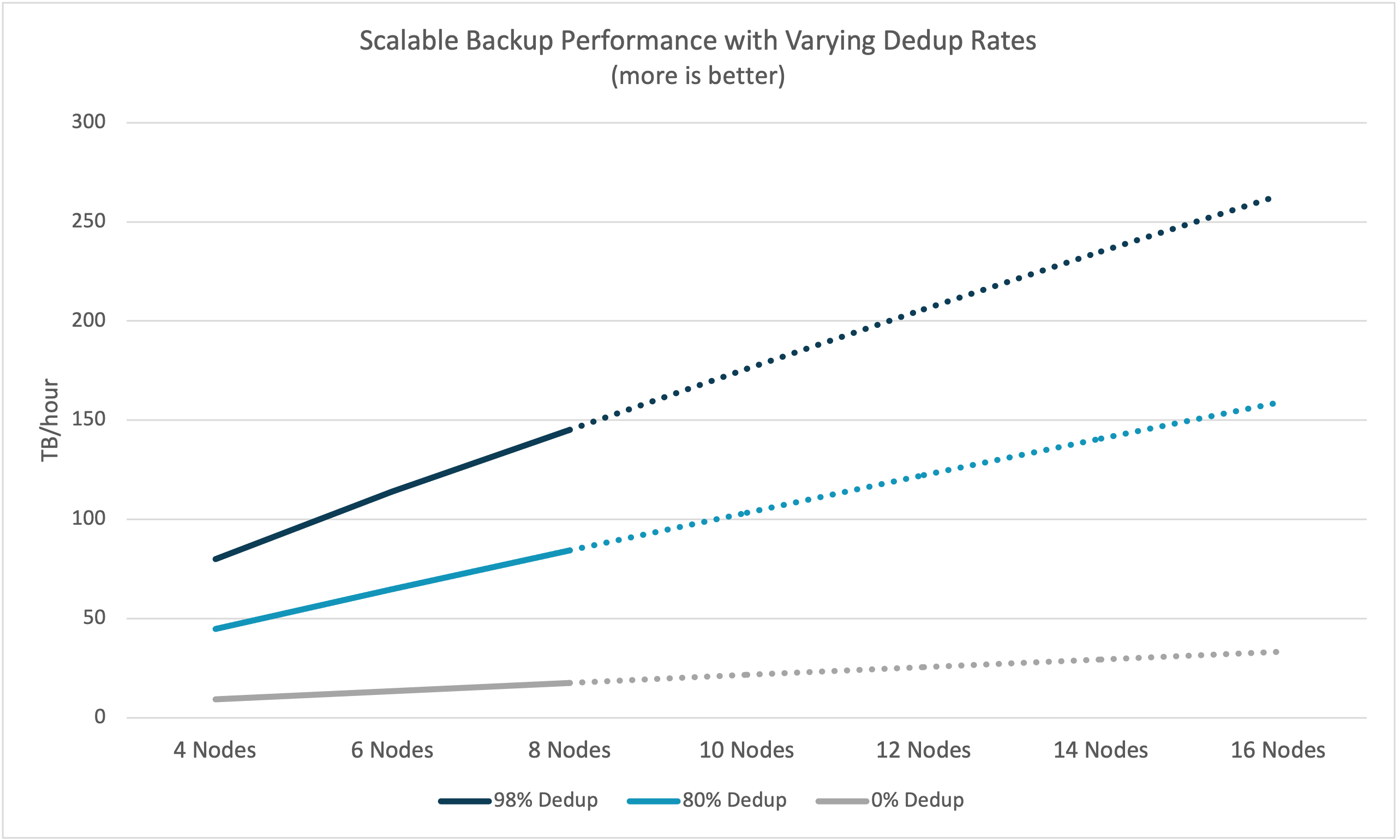
Source: Enterprise Strategy Group
Figure 8. Scalability of Restore Performance
Scalable Restore Performance with Varying Dedup Rates (more is better)
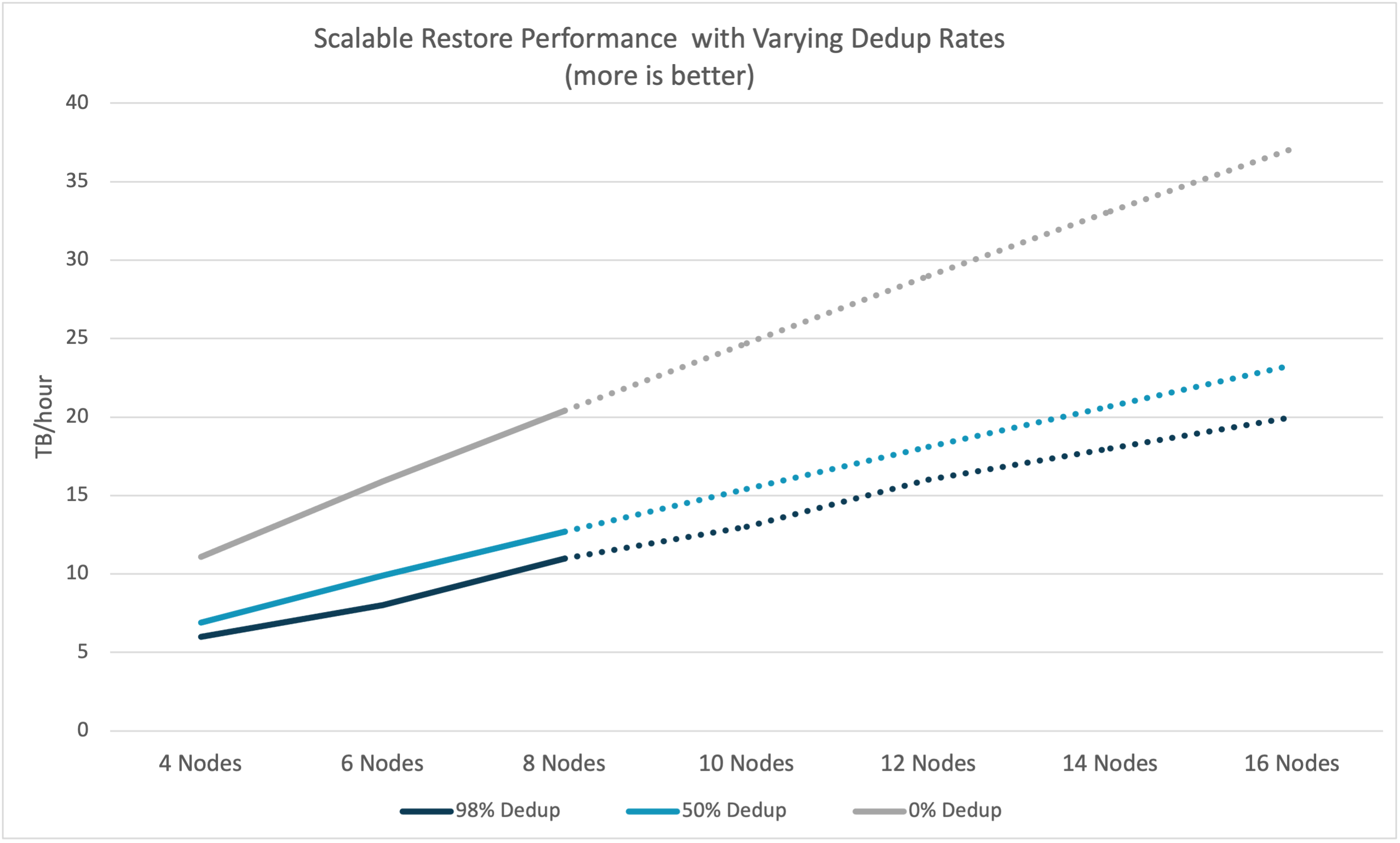
Source: Enterprise Strategy Group
Figure 9. NetBackup Flex Scale High-performance Instant Access VMs
VMware Instant VM Access with OLTP Transactions (more is better)
Source: Enterprise Strategy Group
Why This Matters
Simplicity and automation are important features in a growing environment, but a data protection solution also must deliver backup and restore performance at scale to keep applications both protected and available.
NetBackup Flex Scale was built to scale out, adding disk, CPU, and network resources as nodes are added. ESG validated high performance for both backup and restores, with near-linear scalability as nodes were added regardless of deduplication rates. With eight NetBackup Flex Scale nodes, ESG validated up to 145 TB/hour for backup (37 TB/hour extrapolating to 16 nodes) and up to 11 TB/hour for restores (263 TB/hour extrapolating to 16 nodes). In addition, ESG validated the ability of NetBackup Flex Scale to run 48 instant access VMs with 3,389 TPM on four nodes and 7,401 TPM on eight nodes.
The Bigger Truth
- Deployment. Administrators only rack, cable, and power on the appliance, add a few IP addresses, and the NetBackup Flex Scale software does the rest.
- Scalability. Nodes are automatically discovered; when adding nodes, administrators can choose to optimize resources for backups and restores or for faster reconfiguration. NetBackup Flex Scale adds nodes and rebalances data automatically and non-disruptively.
- Resiliency. Backups continue during multiple disk failures; node upgrades and replacements are automated and non-disruptive, with automatic data rebuilding and cluster rebalancing.
- Performance. Backup and restore displayed enterprise-class performance with near linear scalability at every deduplication rate, with backup reaching 145 TB/hour with eight nodes and restore reaching 20.4 TB/hour.
Simple to scale. Easy to operate. Highly resilient.
This ESG Technical Validation was commissioned by Veritas and is distributed under license from ESG.
1 Source: ESG Research Report, 2021 Technology Spending Intentions Survey, Jan 2021.
2 Source: ESG Research Report, Tape’s Place in an Increasingly Cloud-based IT Landscape, Jan 2021.
3 It should be noted running these tests with additional threads is likely to increase the number of instant access VMs that can be supported. This was not possible in the test bed that was used.
All trademark names are property of their respective companies. Information contained in this publication has been obtained by sources The Enterprise Strategy Group (ESG) considers to be reliable but is not warranted by ESG. This publication may contain opinions of ESG, which are subject to change from time to time. This publication is copyrighted by The Enterprise Strategy Group, Inc. Any reproduction or redistribution of this publication, in whole or in part, whether in hard-copy format, electronically, or otherwise to persons not authorized to receive it, without the express consent of The Enterprise Strategy Group, Inc., is in violation of U.S. copyright law and will be subject to an action for civil damages and, if applicable, criminal prosecution. Should you have any questions, please contact ESG Client Relations at 508.482.0188.

Enterprise Strategy Group | Getting to the Bigger Truth™
Enterprise Strategy Group is an IT analyst, research, validation, and strategy firm that provides market intelligence and actionable insight to the global IT community.
